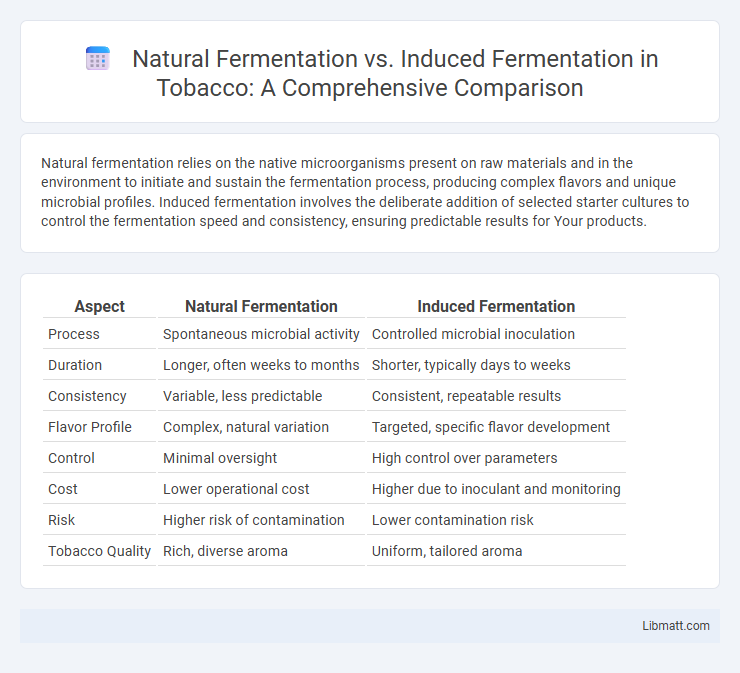Natural fermentation relies on the native microorganisms present on raw materials and in the environment to initiate and sustain the fermentation process, producing complex flavors and unique microbial profiles. Induced fermentation involves the deliberate addition of selected starter cultures to control the fermentation speed and consistency, ensuring predictable results for Your products.
Table of Comparison
| Aspect | Natural Fermentation | Induced Fermentation |
|---|---|---|
| Process | Spontaneous microbial activity | Controlled microbial inoculation |
| Duration | Longer, often weeks to months | Shorter, typically days to weeks |
| Consistency | Variable, less predictable | Consistent, repeatable results |
| Flavor Profile | Complex, natural variation | Targeted, specific flavor development |
| Control | Minimal oversight | High control over parameters |
| Cost | Lower operational cost | Higher due to inoculant and monitoring |
| Risk | Higher risk of contamination | Lower contamination risk |
| Tobacco Quality | Rich, diverse aroma | Uniform, tailored aroma |
Introduction to Fermentation
Natural fermentation relies on wild, naturally occurring microorganisms such as bacteria and yeast present on raw materials or in the environment, facilitating spontaneous biochemical transformations without human intervention. Induced fermentation involves the deliberate addition of specific microbial cultures under controlled conditions to ensure consistent and predictable fermentation outcomes. These two distinct methods influence flavor profiles, fermentation efficiency, and product safety across industries like food, beverages, and biofuels.
What is Natural Fermentation?
Natural fermentation occurs when wild microorganisms, such as bacteria and yeast present in the environment, spontaneously transform sugars into alcohol or acids without added starters. This process relies on the native microbiota found on raw materials or in the production environment, producing unique flavors and textures influenced by local conditions. Your products benefit from natural fermentation's complexity and authentic characteristics shaped by natural microbial diversity.
Understanding Induced Fermentation
Induced fermentation involves the deliberate introduction of selected yeast strains or bacteria to control and accelerate the fermentation process, ensuring consistent flavor and quality in products like beer, wine, or yogurt. This method allows precise regulation of microbial activity, temperature, and fermentation time, resulting in predictable outcomes compared to natural fermentation, which relies on spontaneous microbial populations. Understanding induced fermentation is crucial for industries aiming to optimize production efficiency, microbial stability, and product safety.
Key Differences Between Natural and Induced Fermentation
Natural fermentation relies on wild microorganisms present in the environment or on raw materials, resulting in diverse and spontaneous microbial activity, whereas induced fermentation uses carefully selected starter cultures to control the process and ensure consistency. Your choice between natural and induced fermentation impacts flavor complexity, fermentation time, and safety, with natural methods offering unique taste profiles but less predictability, while induced fermentation provides uniformity and faster results. Key differences also include the level of microbial control, scalability, and the risk of contamination inherent in natural fermentation.
Microbial Diversity in Fermentation Processes
Natural fermentation fosters a rich microbial diversity by relying on indigenous microorganisms present in the environment, which enhances unique flavor profiles and complex biochemical transformations. Induced fermentation uses specific, selected strains to control the process, resulting in more consistent outcomes but reduced microbial variety. Your choice between the two methods impacts the complexity and authenticity of the final fermented product.
Advantages of Natural Fermentation
Natural fermentation promotes unique microbial diversity, enhancing flavor complexity and nutritional value in food products. It requires no added chemicals or starter cultures, supporting organic and sustainable production methods. This traditional process often results in improved gut health due to the presence of diverse probiotics formed naturally.
Benefits of Induced Fermentation
Induced fermentation offers precise control over microbial strains, resulting in consistent flavor profiles and faster production times compared to natural fermentation. It reduces the risk of contamination by selecting specific, beneficial microorganisms, ensuring product safety and quality. This method enhances scalability in industrial processes, making it ideal for large-scale food and beverage manufacturing.
Common Applications in Food and Beverage Industry
Natural fermentation is commonly used in artisanal products like sourdough bread, kimchi, and traditional cheeses, where wild microbes drive complex flavor development over time. Induced fermentation is favored in large-scale production of yogurt, beer, and wine, relying on selected microbial strains to ensure consistent quality and faster fermentation cycles. Your choice between natural and induced fermentation impacts product uniformity, flavor profile, and production efficiency in the food and beverage industry.
Quality and Safety Considerations
Natural fermentation relies on wild microorganisms present in the environment, which can enhance the complexity and depth of flavors but may introduce variability in quality and potential safety risks due to uncontrolled microbial activity. Induced fermentation uses selected starter cultures to ensure consistent product quality, faster fermentation times, and improved safety by suppressing harmful pathogens. Your choice between these methods impacts the balance of flavor authenticity and regulatory compliance in fermented food production.
Choosing the Right Fermentation Method
Choosing the right fermentation method depends on your desired flavor profile and production timeline. Natural fermentation utilizes wild microorganisms, promoting complex, authentic tastes but requiring longer, less predictable processes. Induced fermentation employs selected starter cultures for faster, consistent results, ideal for controlled environments and scaling production.
natural fermentation vs induced fermentation Infographic

 libmatt.com
libmatt.com